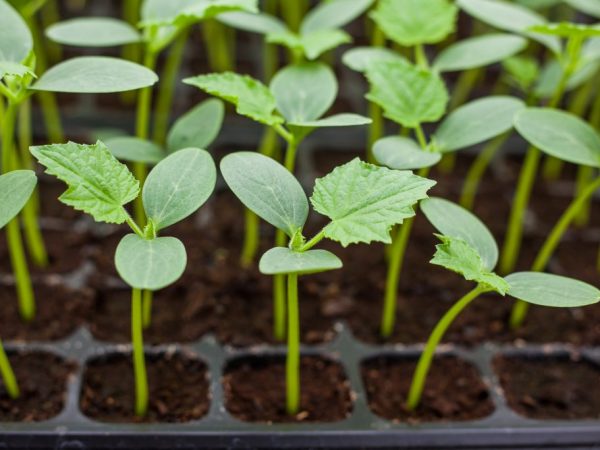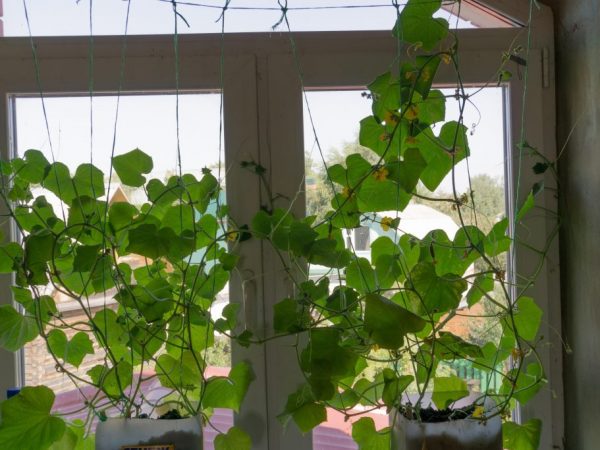Technology for growing cucumbers on the balcony
You can grow cucumbers in a greenhouse all year round. The balcony and loggia are analogous. At the same time, growing cucumbers on the balcony in winter requires a number of conditions. In addition, it is important to choose the right variety. Consider which cucumbers are suitable for growing on the balcony and how to care for them.

Technology for growing cucumbers on the balcony
Requirements for the premises
The culture is thermophilic and does not tolerate drafts, and therefore the balcony must be glazed. Cucumbers also require a lot of light. It is very difficult and costly to grow a vegetable crop on a balcony in the shade of trees or located in the northern part of the house: you will have to illuminate the premises with an artificial light source all day. With insufficient lighting, the culture produces few ovaries and stops bearing fruit early.
As for the temperature regime, the minimum daytime temperature should be 18 ° С, nighttime - 15 ° С. Since even in spring the air temperature rarely meets these conditions, the balcony for growing cucumbers will have to be insulated. With significant changes in day and night temperatures, additional heating is used at night.
Winter cultivation of a crop is associated with additional costs, therefore, before starting to grow cucumbers on the balcony, they create a project that includes the costs of heating and lighting, the purchase of seed and containers for growing. After the creation of the project, it will become clear how economically profitable this event is.
Seed material
Before planting cucumbers, you need to make sure that the selected variety is suitable for the balcony growing method. Breeders have bred varieties intended exclusively for cultivation in a city apartment. You can take a closer look at varieties intended for growing in a greenhouse. It is best to stop the choice on low-growing and self-pollinating plants. Of course, you can always use manual methods of pollination, but they are not always effective and time-consuming, while self-pollinated varieties are guaranteed to yield a crop.
The following are considered the best balcony varieties: City gherkin f1, Courage f1, Balagan f1, Balcony crunch. They are all high yielding and disease resistant.
Step-by-step instruction
In general, planting balcony varieties of cucumbers is not much different from growing seedlings and planting them in open ground. The step-by-step instruction looks like this:
- Seed preparation. Only germinated seeds are planted. To make them germinate faster, they are treated with potassium permanganate and spread on cheesecloth.
- Preparation of containers. Specialty stores have pots and containers of various shapes and sizes. When it comes to growing a small number of bushes, each is planted in a separate pot. Otherwise, it is advisable to plant the seeds in containers. Holes are made at the bottom of pots or containers through which excess moisture will escape. It is better to stop the choice on containers with a depth of 13-15 cm.
- Soil preparation. In order for the cucumbers on the glassed-in balcony to bear fruit well, you need fertile soil, the acidity (pH) of which varies between 3.6-3.8. You can make soil for cucumbers with your own hands by mixing 4 parts of fertile garden soil with 1 part of purchased soil for vegetable crops and 1 part of perlite. Before planting seeds, the soil is treated with a fungicide.
To improve the quality of the land, you can use coffee grounds: it makes the soil looser, which improves its water permeability. For feeding, use exclusively thick roasted coffee beans. It is mixed with the soil in which the culture is planted.
- Sowing seeds. If the seeds are planted in individual containers, a 2 cm deep hole is made in the middle of the container. If the seeds are planted in a common container, the holes are made at a distance of 25-30 cm from each other. The distance between the rows is 20-25 cm. The containers are covered with plastic wrap until shoots appear. It is best to plant cucumber seeds in the ground in the second half of April or early May.
- Cucumber care.
- Harvesting. During the fruiting period, it is advisable to harvest the crop every day. Most varieties are prone to overripe, and overripe fruits lose some of their taste and, as a rule, are not suitable for conservation.
Sometimes it is advised to grow seedlings first in separate containers, and then transfer them to containers, but this measure is effective only when planting in open ground, where weak plants are susceptible to attack by pests. With balcony growing, this threat is minimized.
Balcony cucumber care

Plants need to be well cared for
Planting cucumbers on the balcony is the easiest step in growing a crop. It is much more difficult to provide proper care for cucumbers. Caring for balcony cucumbers includes watering, feeding, garter and plant formation.
In the first month after germination, the plant needs to provide a temperature of 26-28 ° C. You should also protect the vine from direct sunlight.
Watering
Cucumber is a moisture-loving crop that needs to be watered every day. At the same time, it is important not to overflow the culture. With an excess of moisture, fungal and bacterial cultures develop. After watering, the soil should be moist, not wet.
Some gardeners who grow vegetables on the balcony recommend pouring water into the trays located under the containers with the vegetable. Experts do not recommend doing this, since such a measure leads to waterlogging of the soil, which is fraught with rotting of the root system. It is also worth noting here that excess water that has ended up in the pan through the drainage holes must be poured out.
For irrigation, it is advisable to use settled water at room temperature.
Top dressing
It is impossible to grow good cucumbers on the balcony without top dressing. The first feeding is carried out 14 days after germination. At this stage, urea diluted with water is used. Re-feeding is done after 7 days. For 6 liters of water, 1 tbsp is taken. l. urea. To feed one plant, you will need 150-200 ml of such a solution.
In the future, ash, banana peelings, eggshells, coffee grounds, onion peels, potato peelings or sugar are used as top dressing.
Ash
Top dressing with wood ash, which contains phosphorus and potassium, is rightfully considered the most effective. The plant needs these microelements at the stage of growth and flowering. Top dressing is carried out with a liquid solution (1 tablespoon ash per 1 liter of water). In addition to the earth, the leaves of the plant are cultivated.
Eggshell

Plant growth can be stimulated
At home, a growth stimulant is prepared from eggshells. To do this, you need a shell of 4 eggs and 3 liters of water. Pre-crushed shells are placed in the water, the container with water is left in a dark place for 72 hours.It is best to use a glass container that is left open during preparation of the growth promoter. After 72 hours, the water in the container should become cloudy. If this does not happen, the eggshell with water is left in a dark place for another 1-2 days. The plant is watered with this growth stimulant. Leaves are also treated with it. The tool is used in small quantities.
During the preparation of the product, hydrogen sulfide is released, accompanied by an unpleasant odor.
Onion peel
Onion peels are often used for the sub-crust of balcony cucumbers at home. It will not only saturate the vegetable crop with nutrients, but also prevent the spread of diseases, if any.
To prepare top dressing from onion peels, you will need 5 liters of water and 20 g of onion peels. It is best to use boiled water. The husk is poured with water and left for 96 hours. After this time, the infusion is filtered. The resulting product is poured over the bushes and the leaf plates are processed.
Sugar
Sugar gives the plant the energy it needs to grow. It can be used both independently and for preparing a solution. In the first case, the earth is sprinkled with sugar, after which it is watered with warm water. In the second case, sugar is diluted in warm water, and the plant is watered with the resulting liquid. The more sugar you put in the water, the more concentrated the solution will be. For cucumbers, it is better to use mixtures of low concentration (1-2 tablespoons per 1 liter of water).
Banana sedum
Bananas are high in potassium. The skin of an exotic fruit is also rich in this microelement. It is used dry. In the summer, you can dry the banana peel on the windowsill, in the winter - on the battery. The dried banana peel is crushed and added to the soil.
It is undesirable to use the same fertilizers throughout the entire period of crop growth. Each homemade remedy is rich in various microelements and has a different effect on the plant, so nutritional mixes are alternated.
Garter and shaping
Cucumbers need a garter to support the plant. You can tie up a vegetable crop in several ways. The stores sell a special coarse mesh made of thick fishing line. On the sides of the container with seedlings, two supports are installed, to which the mesh is tied. From the materials at hand, you can build its analogue.
As for the formation of the plant, only the central stem is left. All lateral shoots are cut off. With this shape, the bush gives the maximum yield. If necessary, pinch the central stem.
Pests and diseases
In addition to information on how to grow cucumbers on the balcony, you need to know how to protect them from pests. This culture is affected by such harmful insects as aphids, spider mites and whiteflies. Spider mites are fought with the help of garlic tincture, to which soap is added with the addition of soap. Tobacco tincture helps with aphids and whiteflies.
When growing cucumbers that are resistant to fungi, bacteria and diseases on a glassed-in balcony, problems can be avoided. If this or that disease appears, use insecticides sold in specialized stores.


